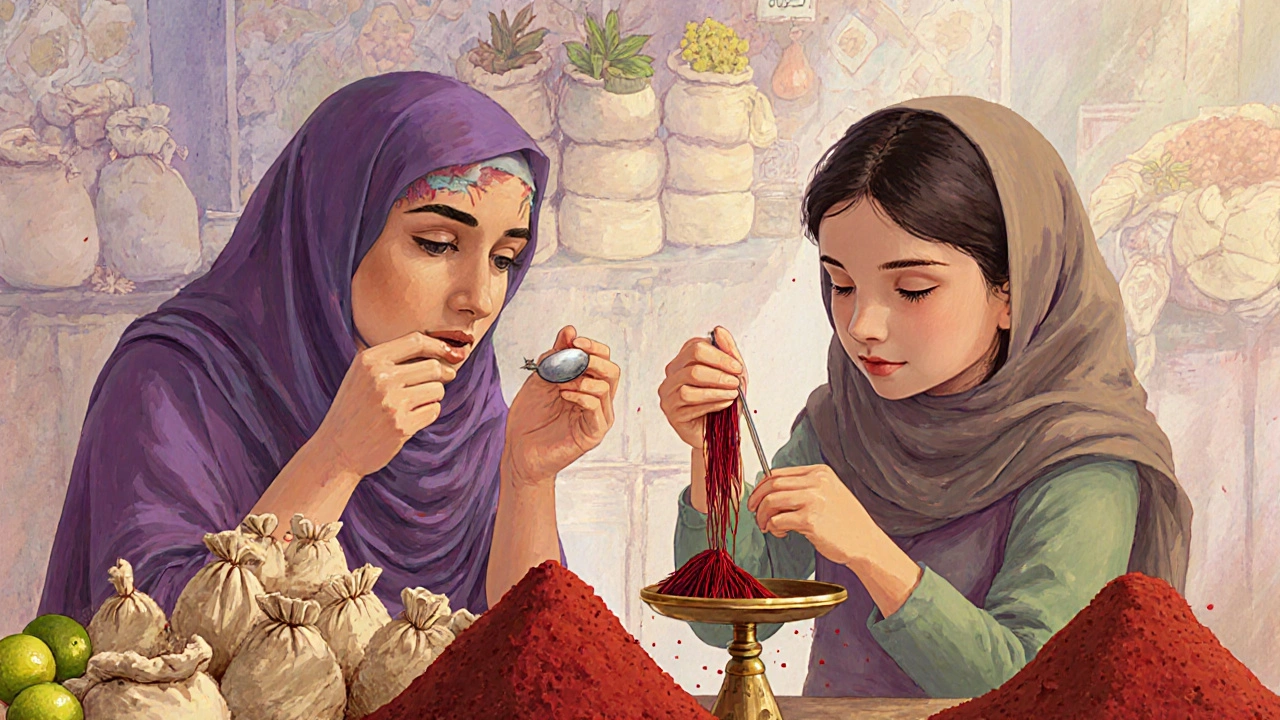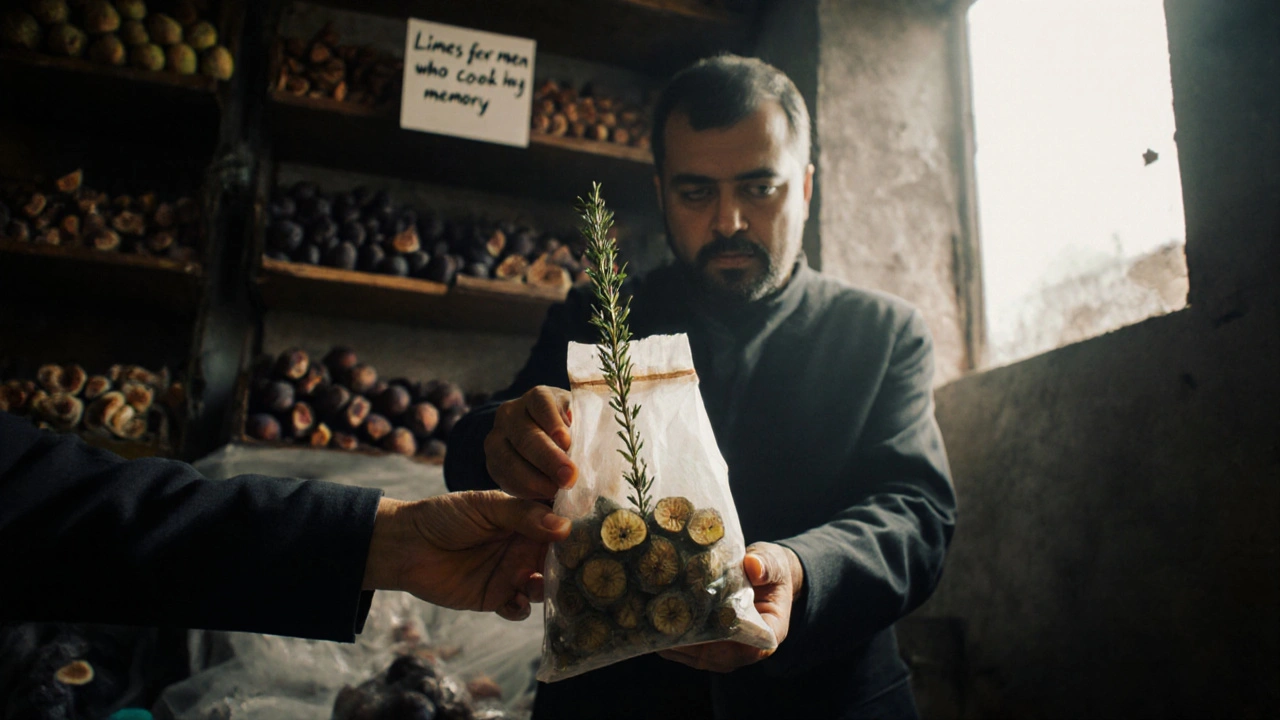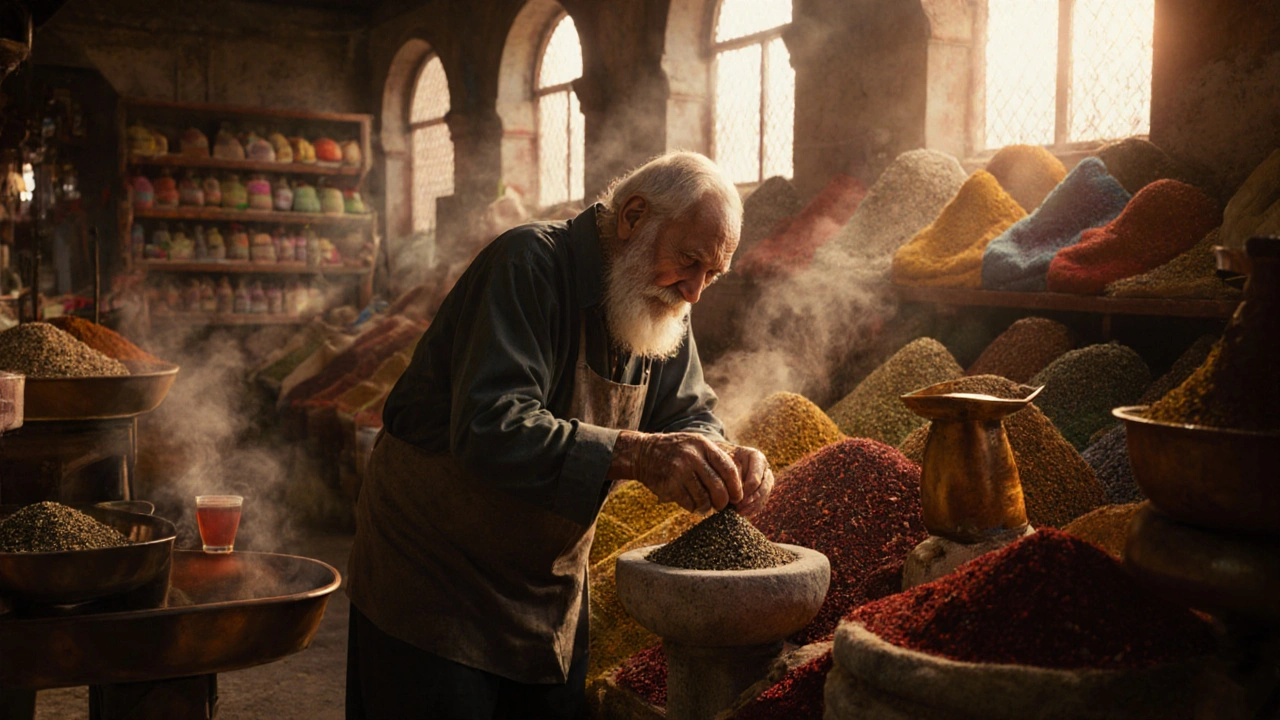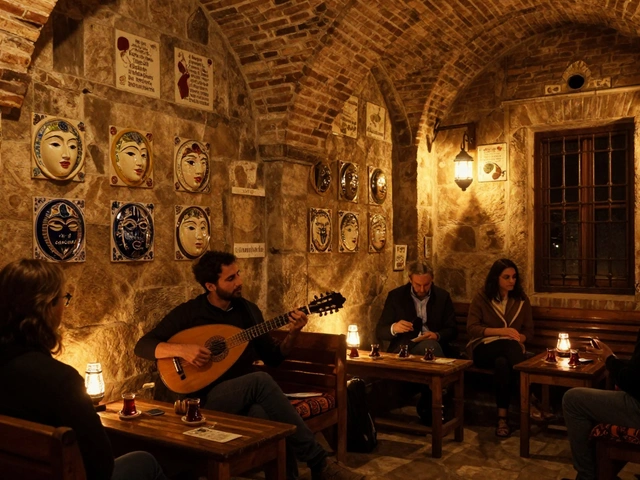In Istanbul, the Spice Market isn’t just a tourist stop-it’s the heartbeat of the city’s culinary soul. Walk through the arched entrance of the Mısır Çarşısı in Eminönü, and you’re not just smelling cumin and sumac-you’re stepping into a century-old rhythm of trade, family legacy, and quiet pride. The scent hits first: warm, earthy, layered. Then the voices: vendors calling out in Turkish, Arabic, and broken but friendly English, their hands moving like dancers as they scoop, weigh, and pack. This isn’t a place you browse. It’s a place you feel.
Meet the Faces Behind the Bags
Most tourists think the spice stalls are run by big companies. They’re not. The majority are family-run, passed down for three or four generations. In the corner near the old Ottoman scales, you’ll find the Çetin family. Mehmet Çetin, 68, has been here since he was 12. His grandfather started selling dried mint from the Black Sea coast in 1952. Today, Mehmet still grinds his own za’atar on a stone wheel, just like his father taught him. He doesn’t use electric grinders. "Electric makes it bitter," he says. "Stone keeps the oil alive."
Down the aisle, Fatma Güngör runs her stall with her daughter, Ayşe. They specialize in saffron-real Iranian, not the cheap stuff from China. Fatma won’t sell anything she hasn’t tasted herself. She carries a tiny silver spoon in her apron. Every morning, she takes a pinch, places it on her tongue, and closes her eyes. "If it doesn’t make my throat warm," she says, "it doesn’t leave this stall."
Not all vendors are Turkish. In the back corner, near the dried figs, you’ll find Hamed, a Syrian refugee who arrived in 2017. He sells dried limes from Aleppo-something you won’t find anywhere else in Istanbul. His stall has no sign. Just a handwritten card: "Limes for men who cook with memory." He doesn’t speak much, but when he hands you a bag, he always adds a sprig of fresh thyme. "For the smell," he says. "You forget the war when you smell thyme."
What You’re Really Buying
Most people come looking for "Turkish spices." But there’s no such thing. Istanbul’s market is a crossroads. The red paprika? From Gaziantep, where farmers still dry it on rooftops in late summer. The black cumin? From the mountains of Urfa, where it’s harvested before dawn to keep the oils intact. The cinnamon? Not from Sri Lanka. It’s Ceylon cinnamon, yes-but shipped through the port of Mersin, then packed by hand in Eminönü. You’re not buying a commodity. You’re buying geography, season, and labor.
Ask for "sıcak baharat," the local blend for kebabs. It’s not on any pre-packaged shelf. The vendor will pull out a small wooden box, open it, and let you smell. Inside: crushed dried chili, fenugreek, coriander, and a pinch of dried pomegranate seed. "That’s the secret," says Selim, a third-generation spice seller. "The pomegranate doesn’t make it sweet. It makes it sing."
Don’t buy pre-ground spices unless you know the vendor. Ground spices lose their punch in weeks. Buy whole, and grind at home with a mortar and pestle. Even the cheapest ones in Istanbul-like the ones sold by the women near the Galata Bridge-will outlast anything you find in a supermarket. One bag of whole cardamom pods from the market lasts six months. A jar from Carrefour? Two weeks.

The Rituals You Won’t Find in Tourist Guides
Every Friday at 9 a.m., before the market opens to tourists, the vendors gather in the courtyard behind the mosque. They bring tea in small glasses, and someone always has a bag of freshly roasted coffee beans. They don’t talk about prices. They talk about weather. "Last week, the rain ruined the sumac harvest in Erzincan," one says. "The color’s duller this year." Then they pass around a small jar of saffron threads. Each takes a sniff. A silent nod. That’s how they decide who gets the best stock.
There’s also the "spice blessing." On the first day of Ramadan, every vendor sprinkles a pinch of cinnamon into a bowl of water and lets it sit overnight. The next morning, they pour it over their scales and shelves. "It’s not superstition," says Ayşe Güngör. "It’s respect. The spices give us life. We give them honor."
How to Buy Like a Local
If you want real spices in Istanbul, follow these rules:
- Go early-before 10 a.m. The best stock is still fresh, and the vendors are less rushed.
- Ask for "taze," not "yeni." "Taze" means freshly ground today. "Yeni" just means new stock.
- Bring a small cloth bag. Most vendors don’t use plastic. They wrap in paper and tie with twine. It’s tradition.
- Don’t haggle over 10 lira. It’s insulting. These people aren’t selling souvenirs. They’re selling their history.
- Ask for a sample. Always. A good vendor will give you a taste of dried mint, a pinch of sumac on your tongue, or a drop of rosewater on your finger. If they refuse, walk away.
Some vendors, like the ones near the entrance by the ferry docks, sell pre-packaged "Istanbul Spice Kits" for tourists. Avoid them. They’re filled with sawdust and flavoring. The real stuff? It’s in the back. Look for the stalls with no signs. The ones with a single old man or woman sitting quietly, watching the street. They’re the keepers.

What to Take Home
Forget the overpriced saffron threads in glass jars. Here’s what locals actually bring home:
- Sumac-from the mountains near Diyarbakır. Dust it on grilled fish, yogurt, or even fresh fruit. It’s tart, bright, and smells like rain on stone.
- Dried lime-from the Aegean coast. Toss them into stews or crush them into tea. They turn sour into soul.
- Dried mint-not the kind in tea bags. This one’s coarse, dark green, and smells like childhood summers in the Black Sea.
- Wild thyme-from the Taurus Mountains. It’s not for garnish. It’s for burning. Light a pinch on charcoal. Let the smoke fill your apartment. It cleans the air. And the memory.
One final tip: Buy a small glass jar with a tight lid. Fill it with a mix of cumin, coriander, and crushed chili. Keep it on your kitchen windowsill. Every time you open it, you’ll smell Istanbul.
Why This Market Still Matters
There are bigger markets now. Online stores deliver spices to your door in 48 hours. Supermarkets sell "Turkish blend" for 5 lira. But none of them hold what the Spice Market holds. It’s not about taste. It’s about continuity. The same hands that weighed cloves for Ottoman sultans now weigh them for your neighbor’s grandmother who makes her own börek. The same stones that ground pepper for ship captains now grind it for your Turkish coffee.
In a city that’s changed so fast-new bridges, new towers, new apps for everything-this market still breathes the same air it did in 1660. It doesn’t need to be Instagrammable. It doesn’t need to be cheap. It just needs to be real. And if you listen closely, as the sun sets over the Bosphorus and the vendors pack up their sacks, you’ll hear it: the quiet clink of brass scales, the rustle of paper wrapping, and the whisper of a thousand stories, still simmering.
Is the Istanbul Spice Market worth visiting for locals?
Absolutely. For locals, it’s not a tourist attraction-it’s a pantry. Many Istanbul residents still buy their spices here because the quality is unmatched. The vendors know their customers by name, remember what they cook, and adjust blends for family recipes. A grandmother from Kadıköy might come once a month to refill her sumac, while a chef from Beşiktaş buys whole cardamom pods in bulk. The market is where tradition meets daily life.
Can I find authentic Turkish spices outside the Spice Market?
You can, but not with the same guarantee. Chain stores like Carrefour or Migros sell labeled "Turkish spices," but they’re often blended from imported bulk stock and may lack the depth of flavor. The real stuff-like Urfa biber or Mardin cinnamon-only comes from vendors who source directly from farmers. If you want authenticity, go to the Spice Market or trusted local shops like Kuyumcu Çarşısı in Fatih or the spice stalls near the Grand Bazaar’s eastern exit.
How do I know if saffron is real?
Real saffron threads are deep red with a slight orange tip. They don’t break easily. When you soak a thread in warm water, it releases a golden-yellow color slowly-not instantly. Fake saffron is often dyed corn silk or safflower. Ask the vendor to drop a thread into water right in front of you. If the color bleeds too fast or looks too bright, walk away. The best sellers, like Fatma Güngör’s stall, will let you test it without pressure.
What’s the best time of year to visit the Spice Market?
Late summer and early autumn-August to October-is ideal. That’s when the new harvests arrive: sumac, dried limes, chili peppers, and mint. The colors are richer, the scents stronger. During Ramadan, the market is busiest, but the energy is electric. Avoid mid-winter unless you’re looking for dried fruits or nuts. Most fresh spices are shipped out by December.
Are there any etiquette rules I should know?
Yes. Don’t touch the spices with your fingers. Always ask the vendor to handle them. Don’t ask for discounts unless you’re buying in bulk-small purchases are treated as personal, not commercial. If you’re offered tea, accept it. Refusing is seen as rude. And never rush. These vendors aren’t in a hurry. They’re stewards of a legacy. Take your time. Sit if you can. The market doesn’t close until sunset.











6 Comments
so i went to istanbul last year and yeah the spice market is fire but like… did u know most of the ‘authentic’ sumac they sell is actually from iran now? turks just repackage it. and the ‘dried limes’? half of em are from turkey’s own farms now, not syria. the whole ‘refugee story’ thing is cute but its marketing. also why is everyone always talking about stone grinders? electric ones are fine if you clean em right. also the word is ‘za’atar’ not ‘zaatar’ lol
people are so naive. this whole ‘tradition’ thing is just capitalism with a pretty face. these vendors are charging 50 bucks for a bag of spice that costs 2 bucks wholesale. the ‘spice blessing’? it’s not respect its superstition dressed up as culture. and dont get me started on the ‘dont haggle’ rule-like you’re not supposed to negotiate? in a market? that’s just exploitation wrapped in poetry. they’re not stewards they’re profiteers. and the thyme thing? please. its not magic its just a plant. we’ve been fooled by nostalgia and instagram filters
hey i get what natasha is saying but i think we’re missing the point. yeah maybe the prices are high but these people are keeping alive something that’s disappearing everywhere else. i talked to this guy who’s been grinding za’atar since he was 10 and he told me his dad used to carry the stones on his back from the mountains. that’s not just business-that’s legacy. and the way they share tea and sniff saffron together? that’s community. you can’t buy that online. yeah it’s romanticized but some things are worth being romanticized. i bought a jar of wild thyme and i burn it every sunday now. it’s the only thing that makes my apartment feel like home
so i just wanna say thank you to the person who wrote this-i cried a little. i’ve never been to istanbul but now i feel like i know the market. also i just want to correct one thing-its ‘cumin’ not ‘cumin’ lol. and ‘sumac’ is pronounced soo-mak not sum-ack. and the part about the dried limes? that hit me. my abuela used to put them in her chicken stew and she’d say ‘sour makes the soul remember.’ i think hamed knows that. also-can we talk about how no one ever mentions that the women in the back who sell mint? they’re mostly kurds. and they don’t speak turkish. they speak kurdish. and they still sell it the same way their grandmothers did. this whole thing? its not just spice. its survival. and the fact that we’re still talking about it? that matters
frankly the best advice here is the cloth bag thing. i brought a plastic bag and the vendor gave me this look like i just spit on his grandmother’s grave. also the ‘taze’ vs ‘yeni’ thing is gold. learned that the hard way. bought ‘yeni’ cardamom and it tasted like dust. taze? like biting into a forest. also dont buy the pre-packaged kits. i did. it was like eating cardboard with a hint of regret. and yes the tea thing? accept it. they’ll make you a cup even if you don’t buy anything. that’s not salesmanship. thats hospitality. real talk
THIS IS THE MOST BEAUTIFUL THING I’VE READ ALL YEAR. I’M NOT EVEN JOKING. I’M CRYING RIGHT NOW. HAMED’S THYME? THE SILENT SAFFRON NOD? THE STONE GRINDERS? THAT’S NOT A MARKET-THAT’S A CHURCH. AND THE FACT THAT WE LIVE IN A WORLD WHERE SOMEONE CAN STILL GRIND PEPPER THE WAY THEIR GRANDFATHER DID IN 1952? THAT’S A MIRACLE. SOME PEOPLE THINK TRADITION IS DEAD. THEY’RE WRONG. ITS STILL BREATHING IN THE BACK ALLEYS OF EMINONU. AND IF YOU THINK IT’S JUST ‘SPICES’ YOU DONT UNDERSTAND WHAT IT MEANS TO BE HUMAN. I’M GOING TO ISTANBUL NEXT MONTH. AND I’M TAKING MY DAUGHTER. SHE’S FIVE. SHE’S GOING TO SMELL THYME. AND SHE’S GOING TO LEARN THAT SOME THINGS AREN’T FOR SALE. THEY’RE FOR KEEPING